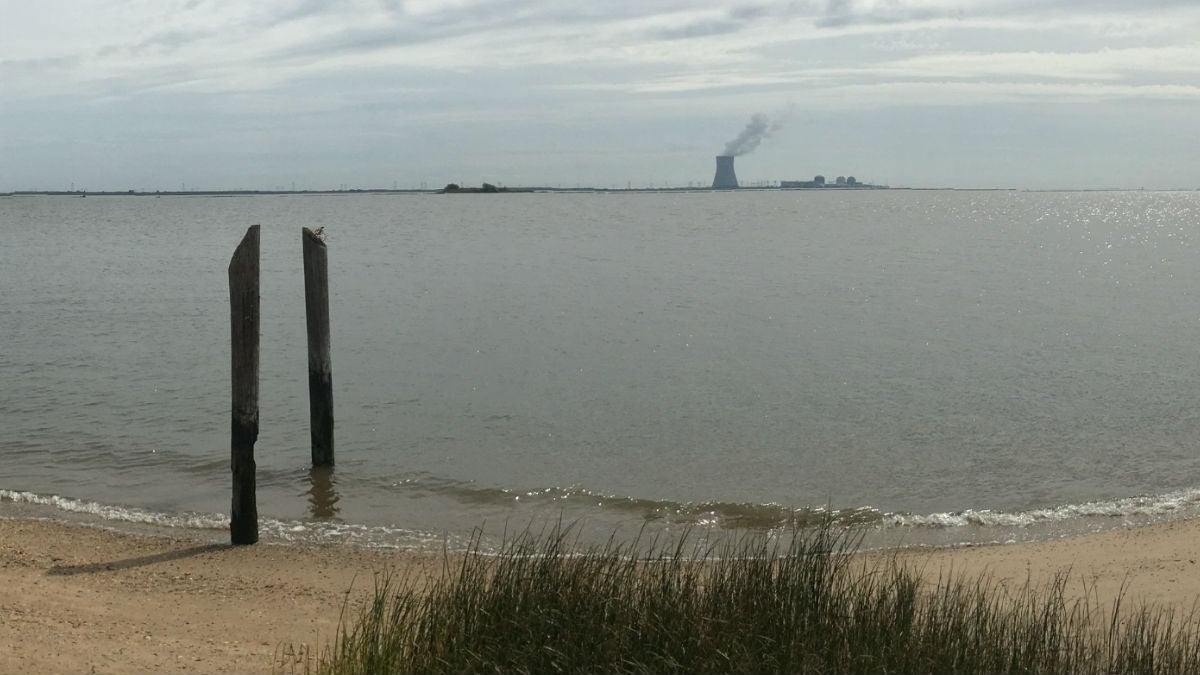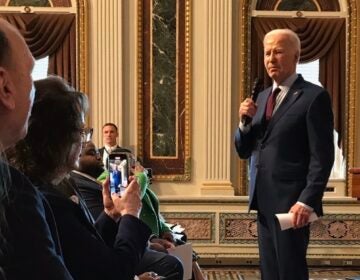Delayed power line project could cost Delaware [video]

The Salem Hope Creek nuclear power plant in New Jersey seen from the Delaware side of the river. This is close to where a proposed underwater powerline would be buried in the river. (Mark Eichmann/WHYY)
It’s on hold for now, but state leaders are still planning to fight the unfair cost structure if the project is restarted next year.
We hear a lot about infrastructure upgrades and the fight over how to pay for those improvements. Those arguments are typically focused on highways and bridges. But a multi-state argument over who should pay for power line upgrades has been brewing for years. And while a powerline project is on hold for now, there’s still concern in Delaware that the state will have to bear an unfair cost to build it.
The nuclear power plant at Artificial Island is just across the Delaware River from the First State, and it’s where the story of this interstate fight begins.
The problem is with the infrastructure around the nuclear plant in southern New Jersey. “The electrical system in southern New Jersey is unstable in the artificial island area,” said Casey Carroll, project manager for LS Power. “As it becomes more and more unstable, the only way the operator can keep the system functioning is to start closing off parts of the system, black outs, localized and those can cascade very quickly when we’re talking a stability issue.”
To solve that problem, LS Power was awarded a $146 million contract to install an underwater powerline from New Jersey to Delaware using a unique process that will bury the line under the river quickly. Burying the line would be done using a tool called a vertical injector. “The tool is essentially a hockey stick shape, and it’s about two feet wide and 70 feet tall, it has nozzles on the front edge and the bottom edge that inject river water into the river bed,” Carroll said. That injected water creates quicksand-like area where the cable is sunk. “We can go from bank to bank on a cable installation in about 24 hours.”
While it may be a worthwhile project and improve the flow of energy throughout the region, Delaware leaders objected to way the project would be paid for. The grid operator, PJM, decided that power customers in Delaware and Maryland would have to pay the bulk of the costs, especially when the problem didn’t fall on the Delaware side of the river:
That didn’t sit well with officials in Delaware like Robert Howatt, Executive Director of the Delaware Public Service Commission. “The problem of course was this was more of a stability issue within the systems operation of the nuclear complex over there, it was a problem with getting their energy out within certain load conditions, the Delmarva zone didn’t cause that problem, and we felt it was patently unfair,” Howatt said.
To protest the cost burden on the Delmarva Peninsula, Delaware’s Governor Markell joined Maryland Governor Larry Hogan in writing a letter to PJM in protest.
“It’s just been a remarkable thing to see just how many people have been coming together in different, from all different industry areas to fight this cost allocation on behalf of the rate payers,” said Heather Contant, Ombudsman at the Delaware PSC.
Residential customers would have seen their power bills go up by about $4 a month. Industrial customers would have seen a massive energy price spike.
“We can’t possibly take on this large of a financial burden on top of the cost we’re already paying,” Contant said. “To throw on this project where some industrial customers are going to see hundreds of thousands of dollars thrown onto their bill…that’s a huge deterrent to people coming into Delaware, and that’s certainly something that people in Delaware are certainly considering.”
But even with all those complaints, the project was moving forward until PSE&G came out with new estimates of what the project would cost.
“Within the last 6 months, that public service electric and gas came in and said oh no, by the way, it’s going to cost this much more to do the station work at the nuclear complex, and that’s when they added this $135 million more to the project costs, which raised it up to $410 million,” Howatt said.
That’s when the grid operator PJM pushed pause on the project, to re-evaluate. PSE&G declined our request for an interview about the project, instead sending us a statement: “This is an iterative process. PSE&G is committed to working with PJM and will provide PJM with any information and support they request.”
PJM also denied a request for an interview on where the project stands. They also sent a statement: “In early August, the PJM board suspended the Artificial Island transmission project and directed staff to perform a comprehensive analysis to support a future course of action.”
PJM plans to announce the future of the project early next year. LS Power’s Casey Carroll hopes the cost issues are worked out so his company can get started on a project he says would bring benefits to Delaware. “There’s reliability benefits, keeping the lights on, especially through extreme weather events, like a hurricane,” Carroll said. “Having that extra tie into the peninsula is important in its independent path.”
PJM is expected to make its decision known in February.
WHYY is your source for fact-based, in-depth journalism and information. As a nonprofit organization, we rely on financial support from readers like you. Please give today.





